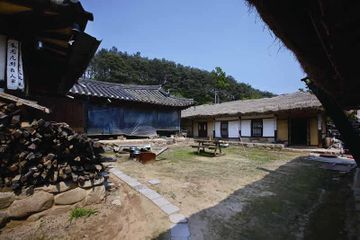"제천 박용원 고택"의 두 판 사이의 차이
(→영문) |
(→영문) |
||
| 39번째 줄: | 39번째 줄: | ||
This is a large farming house consisting of a women’s quarters, men’s quarters, outer quarters, and a storehouse. The women’s and the men’s quarters were built in 1864 and in the early 20th century, respectively. While* it is common for traditional houses to have a linear or an L-shaped layout, the buildings in this house together form a square with a courtyard in the middle. | This is a large farming house consisting of a women’s quarters, men’s quarters, outer quarters, and a storehouse. The women’s and the men’s quarters were built in 1864 and in the early 20th century, respectively. While* it is common for traditional houses to have a linear or an L-shaped layout, the buildings in this house together form a square with a courtyard in the middle. | ||
| − | The women’s quarters consists of, from the left, a kitchen, an underfloor-heated room, a wooden-floored hall, and another underfloor-heated room. Instead of building a separate shrine inside the house to perform ancestral rituals, the family’s ancestors are venerated at a designated area in the wooden-floored hall of the women’s quarters. Another distinctive feature of this house is the ridge posts which support the ridge beam over the main crossbeams. Using several small elements, the posts were made to look like rafters, which is an elaborate technique | + | The women’s quarters consists of, from the left, a kitchen, an underfloor-heated room, a wooden-floored hall, and another underfloor-heated room. Instead of building a separate shrine inside the house to perform ancestral rituals, the family’s ancestors are venerated at a designated area in the wooden-floored hall of the women’s quarters. Another distinctive feature of this house is the ridge posts which support the ridge beam over the main crossbeams. Using several small elements, the posts were made to look like rafters, which is an elaborate technique quite uncommon for residential houses. |
2024년 4월 17일 (수) 04:57 판
| 제천 박용원 고택 Bak Yong-won’s House, Jecheon |
|
 제천 박용원 고택, 국가문화유산포털, 문화재청. |
|
| 대표명칭 | 제천 박용원 고택 |
|---|---|
| 영문명칭 | Bak Yong-won’s House, Jecheon |
| 한자 | 堤川 朴用元 古宅 |
| 주소 | 충청북도 제천시 금성면 구룡리 305번지 |
| 지정번호 | 국가민속문화유산 제137호 |
| 지정일 | 1984년 1월 14일 |
| 분류 | 유적건조물/주거생활/주거건축/가옥 |
| 시대 | 조선시대 |
| 수량/면적 | 3필지/2,249㎡ |
| 웹사이트 | 제천 박용원 고택, 국가문화유산포털, 문화재청. |
해설문
국문
이 집은 안채에 있는 상량문*을 통해 1864년에 만들어졌음을 알 수 있다. 일반적으로 민가는 ‘ㅡ’자부터 ‘ㄱ’자형태로 발전되어 가는데 이 고택은 ‘ㄱ’자 안채, ‘ㅡ’자 사랑채, 아래채, 헛간을 두어 튼 ‘ㅁ’자 구조를 이루는 큰 규모의 농가이다.
이 집의 특별한 점으로 안채의 대청 쪽으로 문을 두고 마당 쪽으로 창을 낸 광이 있다는 점과 보 위에서 마루대를 받치는 대공이 하나의 큰 조각이 아닌 여러 개의 작은 나무로 받치는 구조인 포대공을 사용한 점을 들 수 있다. 포대공은 민가에서 흔히 사용하지 않는 고급스러운 구조이다. 사당을 따로 두지 않고 안채 대청마루에 제사를 지내는 공간을 두었다는 점도 흥미롭다.
이 지역의 제천 후산리 고가에서도 대청마루에 제사를 지내는 공간과 포대공을 확인할 수 있다.
기타 사랑채와 아래채는 원래 초가집으로서 20세기 초에 건축되었다.
- 상량문(上梁文): 집을 새로 짓거나 고친 까닭과 날짜 등을 적은 글이며 주로 마루대 아래 놓는다.
영문
Bak Yong-won’s House, Jecheon
This is a large farming house consisting of a women’s quarters, men’s quarters, outer quarters, and a storehouse. The women’s and the men’s quarters were built in 1864 and in the early 20th century, respectively. While* it is common for traditional houses to have a linear or an L-shaped layout, the buildings in this house together form a square with a courtyard in the middle.
The women’s quarters consists of, from the left, a kitchen, an underfloor-heated room, a wooden-floored hall, and another underfloor-heated room. Instead of building a separate shrine inside the house to perform ancestral rituals, the family’s ancestors are venerated at a designated area in the wooden-floored hall of the women’s quarters. Another distinctive feature of this house is the ridge posts which support the ridge beam over the main crossbeams. Using several small elements, the posts were made to look like rafters, which is an elaborate technique quite uncommon for residential houses.
- I am not sure what they are trying to say here.
영문 해설 내용
이 집은 큰 규모의 농가로 안채, 사랑채, 아래채, 헛간으로 이루어져 있다. 안채는 1864년에 지어졌고, 사랑채와 아래채는 20세기 초에 지어졌다. 일반적으로 민가는 ‘ㅡ’자 또는 ‘ㄱ’자 형태로 구성되는데, 이 집은 건물들이 안마당을 중심으로 ‘ㅁ’자 구조를 이룬다.
안채는 왼쪽에서부터 부엌, 온돌방, 대청, 온돌방으로 이루어져 있다. 한국의 전통 가옥에는 선조의 위패를 모시는 사당을 두는 경우가 많은데, 이 집은 사당을 따로 두지 않고 안채 대청에 제사를 지내는 공간을 두었다. 또한 이 집의 가장 큰 특징은 대들보 위에서 마룻대를 받치는 대공을 여러 개의 작은 부재를 사용해 공포 형식으로 만들었다는 점이다.* 이러한 형식은 민가에서 흔히 사용하지 않는 고급스러운 기법이다.
- 아래 그림의 포대공

